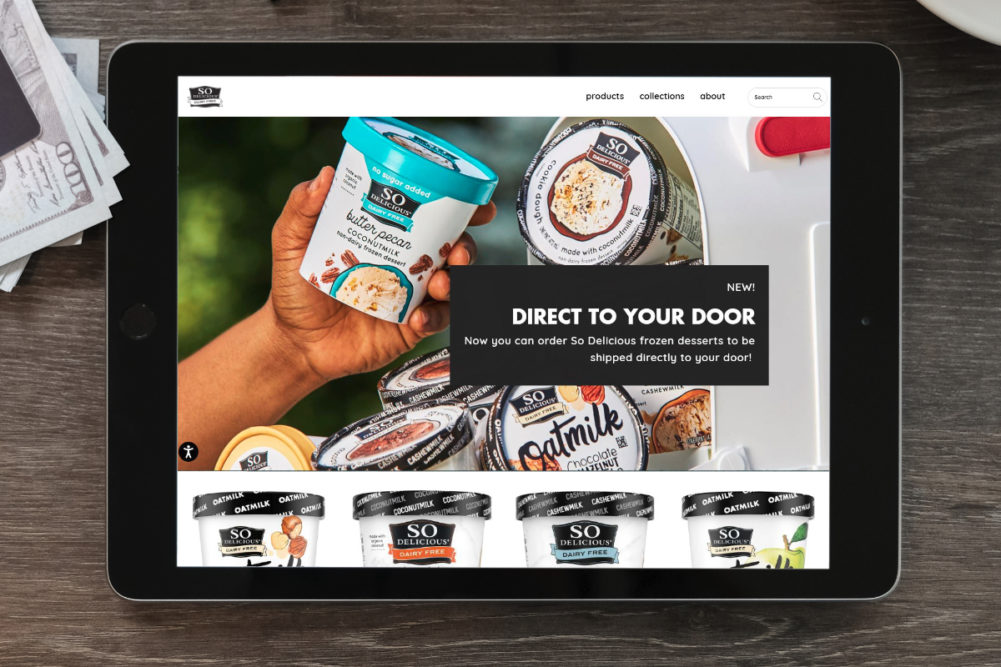BROOMFIELD, COLO. — With e-commerce adoption skyrocketing during the pandemic and online sales expected to reach more than $250 billion by 2025, Danone North America is prioritizing innovation for the virtual shelf.
The company in April launched a direct-to-consumer website for its So Delicious brand of plant-based dairy products.
“We saw a need to meet and attract new consumers that were just engaging with direct-to-consumer platforms or just engaging in digital commerce,” said Kristina Cole, president of sales and chief customer and commercial officer at Danone. “It’s very small for us. It’s a test and we’re learning our way through it.”
While the direct-to-consumer channel accounts for a small part of the overall business, it also offers benefits beyond incremental sales, she added.
“It allows you to get real-time information from consumers to help inform what they’re really looking for,” she said. “It used to take six to eight months to know you had an item that was going to work. Now, you know in days. You can launch a new flavor and get instant feedback. It allows you to tweak your innovation strategy and can help inform future innovation.”
The direct-to-consumer platform is one of several recent e-commerce investments. The company in March launched Honest to Goodness, its first brand to be sold exclusively across online channels. Featuring coffee creamers made with vanilla sourced from Madagascar, Danone is using online displays to highlight the brand’s social and environmental initiatives. Honest to Goodness works with earthday.org to improve communities in Madagascar by planting trees, protecting soil and creating ongoing employment opportunities.
“With the virtual shelf, you can develop a strategy or storytelling narrative that’s more in depth than what you can do in the brick-and-mortar world,” Ms. Cole said.
Danone’s focus on storytelling expands beyond its first digital-only brand. The company is leveraging the virtual shelf to engage with consumers and drive sales across all channels, including traditional brick-and-mortar.
“Consumers are doing more research than ever before, and they’re much better informed about products and ingredients,” Ms. Cole said. “Whether they’re engaging at the brick-and-mortar shelf or at the virtual shelf, they’ve probably made that purchase decision before they click to add an item in their basket or before they go and purchase in-store.”
She pointed to the Two Good yogurt brand as an example. The brand supports social and environmental causes through Danone’s One Cup, Less Hunger program, which aims to reduce food waste and food insecurity. It also works with Full Harvest, a startup rescuing surplus and imperfect produce, to source ingredients that would otherwise go to waste. Communicating those initiatives online has been key to the brand’s success, Ms. Cole said.
“The ability to story tell with regard to the purpose-driven nature of that launch was a critical element in the innovation strategy,” she said. “That’s something that digital commerce allows versus a traditional way of shopping and engaging with products.”
Leveraging the virtual shelf to engage with and better understand consumers will be key to Danone’s omnichannel strategy going forward. The company expects e-commerce adoption will continue accelerating in the post-pandemic environment, even as more consumers return to in-store shopping.
“We expect that by 2022, more than half of consumers in the US are going to be digital grocery shoppers,” Ms. Cole said. “In the last four weeks, we’ve also seen a shift as cities and states are reopening. We’re going to continue to invest in online, but it’s under the halo of a commercial strategy that meets consumers both online and in-store. Ultimately, it’s about meeting the consumer wherever they shop.






